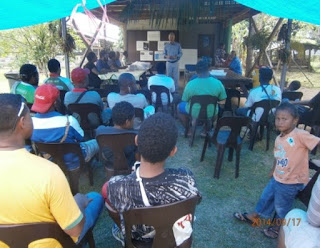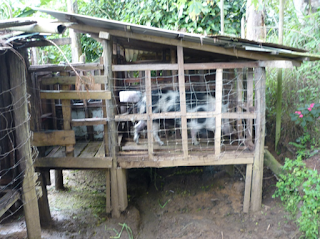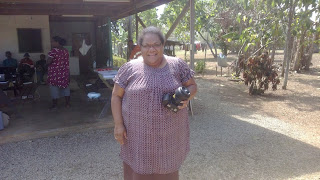12. Field days: getting the word out
In this blog I write about the field days...
Through the drought we pushed along with the commercial elements of the main farm and measuring the performance of each batch of pigs fed the various silages and premixes in the wooden pig house. I wanted to test how receptive the local villages might be about raising some pigs for us. I thought they should see the pigs in our pig houses and see firsthand the cassava silage. Would they be able to grow cassava themselves and process it in the same way?
Through the drought we pushed along with the commercial elements of the main farm and measuring the performance of each batch of pigs fed the various silages and premixes in the wooden pig house. I wanted to test how receptive the local villages might be about raising some pigs for us. I thought they should see the pigs in our pig houses and see firsthand the cassava silage. Would they be able to grow cassava themselves and process it in the same way?
 |
| The field day: Chairs and a tarp for shade set up extended the mess |
 |
| Field day poster: The business |
To this end Miriam and Patrick organized a field day. They put the word out to their local church group. Our first field day was purposely a small affair. There was a lot for us to learn. Later we would run a bigger event and invite the press. Local church or not, forty people turned up from the church community and from the families of our staff. There was considerable interest in what we were doing although I’m sure many were there for the promised pork barbecue.
We kicked the meeting off with a short talk by Wille Kupo, a senior Oil Search executive and Kandiawa man. I gave a short talk about the project, inviting people to inspect the pigs later with Patrick and the senior staff. It was powerpoint free zone. Then Pastor Johnston, a fire and brimstone Baptist pastor and Joyce Pato’s dad, said grace.
 |
| Lunch at the field day. Miriam serving, Yuti with her plate ready |
Miriam and Deborah had done a great deal of cooking and preparation. We served roast potatoes, salad, fruit with the pork plus sliced bread. I had seriously underestimated how much bread people would eat. Even Yuti’s plate was overflowing with pork and three or four slices of bread. It gave me the impression that these folks never knew where the next meal was coming from and often went hungry. Having collected their lunch (in’ traditional’ takeaway Styrofoam trays) they sat around on the grass, eschewing the chairs we had set out and set about the deadly serious business of eating lunch with their fingers. Our BBQ pork was juicy, had a gentle flavor and was sweet. It was very, very good. These animal shad been raised on cassava silage and the protein balancer. Part of the plan was for people to see how good our meat was, that it was free of some of the adverse flavours sometimes associated with boar taint or fish meal or rancid meat meal sometimes added to some diets as a protein supplement. Our protein supplements were soy bean meal based. I told the group later, during the presentations, that the pork we had served had been reared by PNG people, locally in Port Moresby and that it was as good as any in the world.
After lunch we divided the group into four and sent them off on a tour of the farm with a focus on the pig house and the cassava silage. It had become clear during my talk before lunch that there were perhaps only about four people who were seriously interested in working with us. All the others wanted to look at the pigs, some wanted to see what their relative’s work was all about and some had just come for lunch. However, everybody took great interest in what the tour leaders were saying. Patrick, Nerius, Lester and Isidor provided a detailed description of what the project was about. They had a good grasp of the subject matter.
Over the following months we continued to talk with the four villagers who were most interested in the project. One had travelled about 200 kilometres to be with us. It was fine gesture, but I couldn’t see how we could work with him at that distance. We needed to be able to visit them each month and at that stage none of our staff was licensed to drive. We didn’t even have our own vehicle. That person eventually bought some pigs from us and went on breeding them and raising them very successfully.
Another villager, a relative of Isidor, was very keen. He was a retired civil servant with some savings in superannuation. Raising some pigs was an ideal thing for him to do but his problem was land. He just didn’t have enough of it. His village land holdings were elsewhere, and his Port Moresby land was too small to grow the 5 tonnes of cassava needed to feed the ten pigs.
Our other two contenders were constrained by funds. They had the land but couldn’t raise the funds to both buy the young pigs and build the pig house. We tried to organize microfinance, but the microfinance banks wanted people to start paying back the loan immediately. That was impossible for our people who had to wait 5 months until their pigs were sold. It forced us to look for ways to support the villagers.
Next blog: The highlands



Comments
Post a Comment